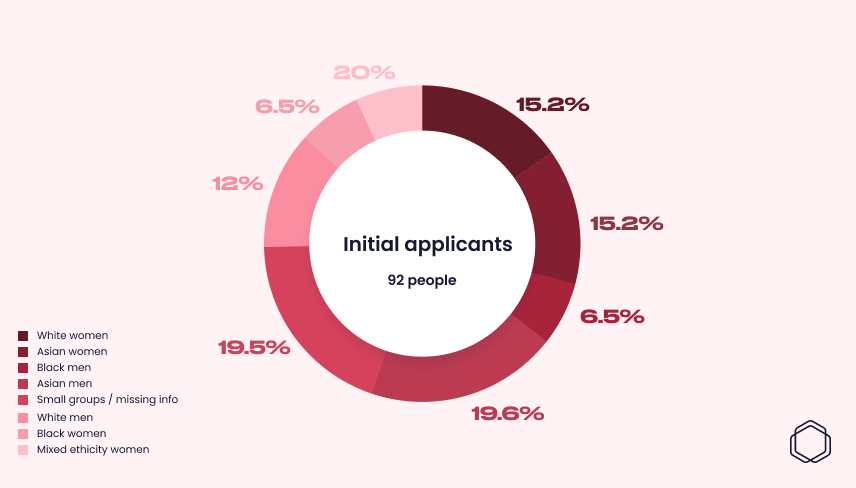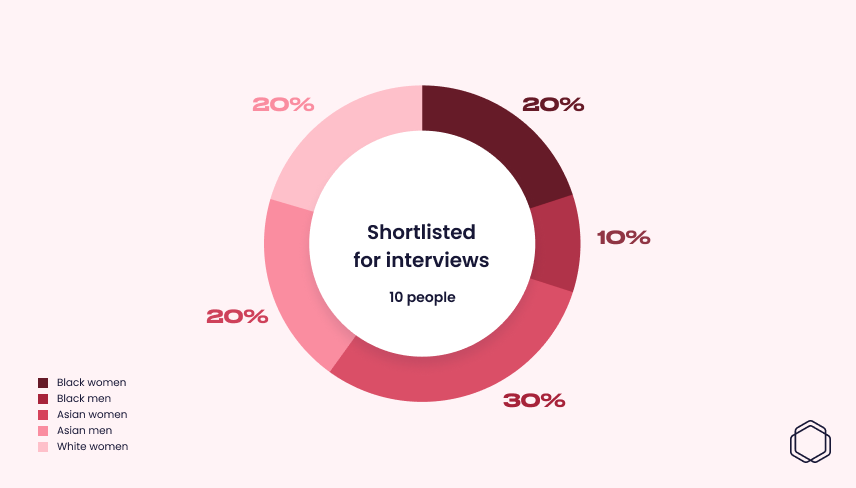How we hire fairly at Fair HQ

At Fair HQ, we help companies embed fair and equitable processes across their entire organisation. A major part of that is setting up a debiased hiring process. There are many pieces to the puzzle — we have 30 unique recommendations focused just on hiring! We know how important it is to walk the talk. That’s why we put all that knowledge to work when hiring our new Business Intern. And the results showed how impactful these actions are. Read on to see what we achieved with debiased hiring.
What’s wrong with traditional hiring?
Setting up an equitable hiring process means shaking up the traditional way of doing things. It can feel a bit scary to break from convention, but it’s well worth it. Making several small tweaks to the way you do things has a massive impact.
What does your hiring look like? Maybe it goes something like this… You skim some CVs, conduct a few loosely structured interviews, choose the best fit and bang — you’ve got the job. And why fix what’s not broken? Well, because actually, it is pretty broken…
If you’re not careful to craft a hiring process with fairness front and centre, bias can rear its ugly head and thwart your efforts of finding your star hire. Mental shortcuts can get in between you and the perfect candidate before you’ve even interviewed them. Make no mistake, this is bad news for diversity, and for you.
A wider range of backgrounds means a wider range of experiences, voices and perspectives. Innovation thrives on alternative viewpoints and creative tension – use this to your advantage!
A fairer way to hire
The latest research in behavioural science tells us that to cut out bias, we should opt for a standardised interview process where candidates are evaluated consistently. We decided to put that research to work when hiring our new Business Intern.

To show you the impact of standardised hiring, we took the time to de-bias every stage of our hiring process, from writing the job description to sending our offer.
And don’t worry — we made it easy for you to get started too. The rest of our series on fair hiring will dive into detailed guidance on how to set up every step of the process. Here’s what we did:
✅ Checklist of actions
- Write a job description that sells the position and attracts a broad range of candidates
- Cast a wide net by posting on diverse job boards
- Ditch CVs, ask candidates to fill in a survey outlining their capabilities and passion instead
- Conduct structured interviews
- Interview for ‘value alignment’, not ‘culture fit’
- Use a work sample to assess job-related skills
- Hire your superstar candidate!
Spoiler alert: What we achieved with debiased hiring
Before diving into the nitty-gritty of fair hiring, here’s a snapshot of just how powerful these actions are.
Like any other strategic project, you want to collect data to help you understand if you’re on the right track. All candidates recorded their gender and ethnicity, which we kept separate from their main application. We measured the diversity of our initial applicant pool and at each drop-off stage of the hiring process.
Let’s take a look at the numbers!
Diversity in our pipeline
From the get-go, we attracted a wonderfully diverse talent pool. 18 unique combinations of ethnicity and gender were represented 😮 (we combined the smallest groups). That showed us that the role and job posting was attractive enough to appeal to a diverse range of people.

To be really clear, this was a super junior role and we didn’t have to do any proactive sourcing. We didn’t require any educational background or specific experience. When sourcing product designers, engineers and managers, we’ve had a harder time.
We have to do lots of sourcing for senior and specialised roles, which is hard to do in a debiased way — people’s faces and names are front and centre. Look out for a future blog post on our experience hiring these roles.
What’s really impressive though is that we maintained diversity all the way through to the final shortlist.
After sifting candidates based on their application and work samples (without seeing their gender or ethnicity!), we ended up with a balanced finalist pool.
Groups that are typically underrepresented in the UK tech scene actually made up the majority of our shortlist: 70% were women, 80% were from underrepresented ethnic backgrounds, and 50% were women of colour.

There you have it — solid proof of the power of debiased hiring. We put the research to the test and it passed with flying colours.
These interventions allowed us to judge candidates based solely on merit rather than their background. The work definitely paid off; we hired a superstar candidate 🤩.
That’s just the start of the story. The next posts in this series will show you how to implement an end-to-end fair hiring set-up, packed with step-by-step guidance and plenty of examples.
Stay tuned.
Backing it up
Bohnet, I., (2016). ‘What Works: Gender equality by design’ Harvard University Press
The Behavioural Insights Team (2021) ‘How to improve gender equality in the workplace: Evidence-based actions for employers‘ How to improve gender equality toolkit